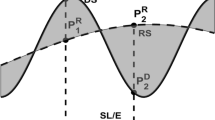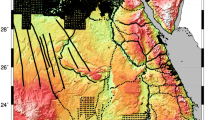Abstract
In many modern local and regional gravity field modelling concepts, the short-wavelength gravitational signal modeled by the residual terrain modelling (RTM) technique is used to augment global geopotential models, or to smooth observed gravity prior to data gridding. In practice, the evaluation of RTM effects mostly relies on a constant density assumption, because of the difficulty and complexity of obtaining information on the actual distribution of density of topographic masses. Where the actual density of topographic masses deviates from the adopted value, errors are present in the RTM mass-model, and hence, in the forward-modelled residual gravity field. In this paper we attempt to overcome this problem by combining the RTM technique with a high-resolution mass-density model. We compute RTM gravity quantities over New Zealand, with different combinations of elevation models and mass-density assumptions using gravity and GPS/levelling measurements, precise terrain and bathymetry models, a high-resolution mass-density model and constant density assumptions as main input databases. Based on gravity observations and the RTM technique, optimum densities are detected for North Island of ~2500 kg m−3, South Island of ~2600 kg m−3, and the whole New Zealand of ~2590 kg m−3. Comparison among the three sets of residual gravity disturbances computed from different mass-density assumptions show that, together with a global potential model, the high-resolution New Zealand density model explains ~89.5% of gravitational signals, a constant density assumption of 2670 kg m−3 explains ~90.2%, while a regionally optimum mass-density explains ~90.3%. Detailed comparison shows that the New Zealand density model works best over areas with small residual heights. Over areas with larger residual heights, subsurface density variations appear to affect the residual gravity disturbance. This effect is found to reach about 30 mGal over Southern Alpine Fault. In order to improve the RTM modelling with mass-density maps, a higher-quality mass-density model that provides radially varying mass-density data would be desirable.
Similar content being viewed by others
References
Amos M.J., 2007. Quasigeoid Modelling in New Zealand to Unify Multiple Local Vertical Datums. PhD Thesis. Curtin University of Technology, Perth, Australia.
Becker J.J., Sandwell D.T., Smith W.H.F., Braud J., Binder B., Depner J., Fabre D., Factor J., Ingalls S., Kim S-H., Landner R., Marks K., Nelson S., Pharaoh A., Trimmer R., Rosenberg J.V., Wallace G. and Weather P., 2009. Global bathymetry and elevation data at 30 arc seconds resolution: SRTM30_PLUS. Mar. Geod., 32, 355–371.
Bucha B. and Janak J., 2014. A MATLAB-based graphical user interface program for computing functionals of the geopotential up to ultra-high degrees and orders: Efficient computation at irregular surfaces. Comput. Geosci., 66, 219–227.
Bucha B., Janák J., Papčo J. and Bezděk A., 2016. High-resolution regional gravity field modelling in a mountainous area from terrestrial gravity data. Geophys. J. Int., 207, 949–966.
Chen W. and Tenzer R., 2014. Harmonic coefficients of the Earth’s Spectral Crustal Model 180 — ESCM180. Earth Sci. Inf., 8, 147–159.
Claessens S.J., Hirt C., Amos M.J., Featherstone W.E. and Kirby J.F., 2011. The NZGEOID09 model of New Zealand. Surv. Rev., 43, 2–15.
Dziewonski A. M. and Anderson D.L., 1981. Preliminary reference Earth model. Phys. Earth Planet. Inter., 25, 297–356.
Dziewonski A.M., Hales A.L. and Lapwood E.R., 1975. Parametrically simple Earth models consistent with geophysical data. Phys. Earth Planet. Inter., 10, 12–48.
Eshagh M., 2009. The effect of lateral density variations of crustal and topographic masses on GOCE gradiometric data — A study in Iran and Fennoscandia. Acta Geod. Geophys., 44, 399–418.
Farr T.G., Paul A.R., Edward C., Robert C., Riley D., Scott H., Kobrick M., Paller M., Rodriguez E., Roth L., Seal D., Shaffer S., Shimada J., Umland J., Werner M., Oskin M., Burbank D. and Alsdorf D., 2007. The Shuttle Radar Topography Mission. Rev. Geophys., 45, RG2004.
Förste C., Bruinsma S.L., Abrikosow O., Lemoine J.M., Marty J.C., Flechtner F., Balmino G., Barthelmes F. and Biancale R., 2014. EIGEN-6C4 The latest combined global gravity field model including GOCE data up to degree and order 2190 of GFZ Potsdam and GRGS Toulouse. GFZ Data Services, GFZ Potsdam, Germany, DOI: https://doi.org/10.5880/icgem.2015.1
Forsberg R., 1984. A Study Terrain Reductions, Density Anomalies and Geophysical Inversion Methods in Gravity Field Modelling. Report No. 355, Department of Geodesic Science and Survey, Ohio State University, Columbus, OH.
Forsberg R. and Olesen A.V., 2010. Airborne gravity field determination. In: Xu G.C. (Ed.), Sciences of Geodesy — I. Springer-Verlag, Berlin, Germany, 83–104.
Forsberg R. and Tscherning C.C., 1981. The use of height data in gravity field approximation by collocation. J. Geophys. Res., 86, 7843–7854.
Gilardoni M., Reguzzoni M. and Sampietro D., 2016. GECO: a global gravity model by locally combining GOCE data and EGM2008. Stud. Geophys. Geod., 60, 228–247.
Gladkikh V. and Tenzer R., 2011. A mathematical model of the global ocean saltwater density distribution. Pure Appl. Geophys., 169, 249–257.
Grombein T., Seitz K. and Heck B., 2013. Optimized formulas for the gravitational field of a tesseroid. J. Geodesy, 87, 645–660.
Heck B. and Seitz K., 2007. A comparison of the tesseroid, prism and point-mass approaches for mass reductions in gravity field modelling. J. Geodesy, 81, 121–136.
Hinze W.J., 2003. Bouguer reduction density, why 2.67? Geophysics, 68, 1559–1560.
Hirt C., 2010. Prediction of vertical deflections from high-degree spherical harmonic synthesis and residual terrain model data. J. Geodesy, 84, 179–190.
Hirt C., 2013. RTM gravity forward-modeling using topography/bathymetry data to improve high-degree global geopotential models in the coastal zone. Mar. Geod., 36, 183–202.
Hirt C., 2016. Gravity forward modelling. In: Grafarend E. (Ed.), Encyclopedia of Geodesy. Springer, Cham, Switzerland, DOI: https://doi.org/10.1007/978-3-319-02370-0_106-1.
Hirt C., Claessens S., Fecher T., Kuhn M., Pail R. and Rexer M., 2013. New ultrahigh-resolution picture of Earth’s gravity field. Geophys. Res. Lett., 40, 4279–4283.
Hirt C., Featherstone W. E. and Marti U., 2010. Combining EGM2008 and SRTM/DTM2006.0 residual terrain model data to improve quasigeoid computations in mountainous areas devoid of gravity data. J. Geodesy, 84, 557–567.
Hirt C. and Flury J., 2008. Astronomical-topographic levelling using high-precision astrogeodetic vertical deflections and digital terrain model data. J. Geodesy, 82, 231–248.
Hirt C., Kuhn M., Claessens S., Pail R., Seitz K. and Gruber T., 2014. Study of the Earth’s shortscale gravity field using the ERTM2160 gravity model. Comput. Geosci., 73, 71–80.
Hirt C. and Rexer M., 2015. Earth2014: 1 arc-min shape, topography, bedrock and ice-sheet models — Available as gridded data and degree 10,800 spherical harmonics. Int. J. Appl. Earth Obs. Geoinf., 39, 103–112.
Huang J., Vanicek P., Pagiatakis S.D. and Brink W., 2001. Effect of topographical density on the geoid in the Canadian Rocky Mountains. J. Geodesy, 74, 805–815.
Jarvis A., Reuter H.I., Nelson A. and Guevara E., 2008. Hole-filled SRTM for the global Version 4. CGIAR-CSI SRTM 90m Database (https://doi.org/http://srtm.csi.cgiar.org).
Jekeli C., Yanh H.J. and Kwon J.H., 2009. Evaluation of EGM08-globally and locally in South Korea. In: Huang J. and Kotsakis C. (Eds), External Quality Evaluation Reports of EGM08. Newton’s Bulletin, 4, 38–49 (https://doi.org/http://www.isgeoid.polimi.it/Newton/Newton_4/NEWTON4_TOTAL.pdf).
Jiang T. and Wang Y.M., 2016. On the spectral combination of satellite gravity model, terrestrial and airborne gravity data for local gravimetric geoid computation. J. Geodesy, 90, 1405–1418.
Kuhtreiber N., 1998. Precise geoid determination using a density variation model. Phys. Chem. Earth, 23, 59–63.
Kuhn M. and Hirt C., 2016. Topographic gravitational potential up to second-order derivatives: an examination of approximation errors caused by rock-equivalent topography (RET). J. Geodesy, 90, 883–902.
Li X. and Grötze H.J., 2001. Tutorial-ellipsoid, geoid, gravity, geodesy, and geophysics. Geophysics, 66, 1660–1668.
Martinec Z., 1993. Effect of Lateral Density Variations of Topographical Masses in View of Improving Geoid Model Accuracy over Canada. Final Report of DSS contract No. 23244-2-4356. Geodetic Survey of Canada, Ottawa.
Martinec Z., Vaniček P., Mainville A. and Veronneau M., 1995. The effect of lake water on geoidal height. Manuscipta Geodaetica, 20, 193–203.
Nagy D., Papp G. and Benedek, J., 2000. The gravitational potential and its derivatives for the prism. J. Geodesy, 74, 552–560.
NASA, 2015. The Shuttle Radar Topography Mission (SRTM) Collection User Guide (https://doi.org/https://lpdaac.usgs.gov/sites/default/files/public/measures/docs/NASA_SRTM_V3.pdf).
Omang O.C.D. and Forsberg R., 2000. How to handle topography in practical geoid determination: three examples. J. Geodesy, 74, 458–466.
Omang O.C.D., Tscherning C.C. and Forsberg R., 2012. Generalizing the harmonic reduction procedure in residual topographic modeling. In: Sneeuw N., Novák P., Crespi M. and Sanso F. (Eds), VII Hotine-Marussi Symposium on Mathematical Geodesy. International Association of Geodesy Symposia 137, 233–238, Springer-Verlag, Berlin, Heidelberg, Germany.
Pasyanos M.E., Masters T.G., Laske G. and Ma Z., 2014. LITHO 1.0: An updated crust and lithospheric model of the Earth. J. Geophys. Res. Solid Earth, 119, 2153–2173.
Pavlis N.K., Holmes S.A., Kenyon S.C. and Factor J.K., 2012. The development and evaluation of the Earth Gravitational Model 2008 (EGM2008). J. Geophys. Res.-Solid Earth, 117, 1978–2012.
Rexer M. and Hirt C., 2015. Spectral analysis of the Earth’s topographic potential via 2D-DFT: a new data-based degree variance model to degree 90,000. J. Geodesy, 89, 887–909.
Rexer M., Hirt C., Bucha B. and Holmes S., 2018. Solution to the spectral filter problem of residual terrain modelling (RTM). J. Geodesy, 92, 675–690.
Root B.C., Novák P., Dirkx D., Kaban M., van der Wal W. and Vermeersen L.L.A., 2016. On a spectral method for forward gravity field modelling. J. Geodyn., 97, 22–30.
Sjöberg L.E., 2004. The effect on the geoid of lateral topographic density variations. J. Geodesy, 78, 34–39.
Tenzer R. and Hamayun P.I., 2010. A Comparison of various integration methods for solving Newton’s integral in detailed forward modelling. In: Mertikas S.P. (Ed.), Gravity, Geoid, and Earth Observation. International Association of Geodesy Symposia 135, 361–368, Springer-Verlag, Berlin, Heidelberg, Germany.
Tenzer R., Novák P. and Gladkikh V., 2011a. On the accuracy of the bathymetry-generated gravitational field quantities for a depth-dependent seawater density distribution. Stud. Geophys. Geodaet., 55, 609–626.
Tenzer R., Sirguey P., Rattenbury M. and Nicolson J., 2011b. A digital rock density map of New Zealand. Comput. Geosci., 37, 1181–1191.
Tenzer R., Novák P. and Gladkikh V., 2012. The bathymetric stripping corrections to gravity field quantities for a depth-dependent model of the seawater density. Mar. Geod., 35, 198–220.
Tenzer R., Chen W., Tsoulis D., Bagherbandi M., Sjoberg L. E., Novák P. and Jin S.G., 2014. Analysis of the refined CRUST1.0 crustal model and its gravity field. Surv. Geophys., 36, 139–165.
Tenzer R, Hirt C., Novák P., Pitoňák M. and Šprlák, M., 2015. Contribution of mass density heterogeneities to the quasigeoid-to-geoid separation. J. Geodesy, 90, 65–80.
Torge W. and Müller J., 2012. Geodesy. 4th Edition. De Gruyter, Berlin/Boston.
Tsoulis D., 2012. Analytical computation of the full gravity tensor of a homogeneous arbitrarily shaped polyhedral source using line integrals. Geophysics, 77, F1–F11.
Tziavos I.N. and Featherstone W.E., 2001. First results of using digital density data in gravimetric geoid computation in Australia. In: Sideris M.G. (Ed.), Gravity, Geoid, and Geodynamics 2000. International Association of Geodesy Symposia 123, 335–340, Springer-Verlag, Berlin, Heidelberg, Germany.
Tziavos I.N. and Sideris M.G., 2013. Topographic reductions in gravity and geoid determination. In: Sanso F. and Sideris M.G. (Ed.), Geoid Determination Theory and Methods. Lecture Notes in Earth System Sciences 110, 337–400, Springer-Verlag, Berlin, Germany.
Tziavos I.N., Vergos G.S. and Grigoriadis V.N., 2010. Investigation of topographic reductions and aliasing effects on gravity and the geoid over Greece based on Various digital terrain models. Surv. Geophys., 31, 23–67.
Wu Y.H., Luo Z.C., Chen W. and Chen Y.Q., 2017. High-resolution regional gravity field recovery from Poisson wavelets using heterogeneous observational techniques. Earth Planets Space, 69, 2–15.
Author information
Authors and Affiliations
Corresponding author
Rights and permissions
About this article
Cite this article
Yang, M., Hirt, C., Tenzer, R. et al. Experiences with the use of mass-density maps in residual gravity forward modelling. Stud Geophys Geod 62, 596–623 (2018). https://doi.org/10.1007/s11200-017-0656-z
Received:
Revised:
Accepted:
Published:
Issue Date:
DOI: https://doi.org/10.1007/s11200-017-0656-z




